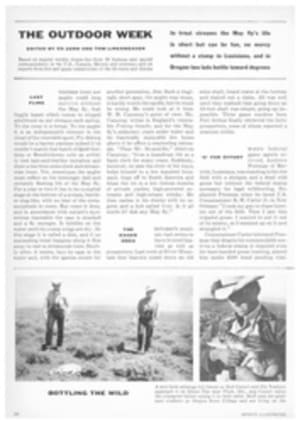
50 MILLION CAMPERS HIT THE TRAIL
In the next few weeks almost one-third of the U.S. population will take to the fields and woods in the biggest exodus to the outdoors this nation has yet seen. Loaded with confidence and thousands of pounds of comfort-promising equipment, 50 million campers are preparing to move out on foot, by car, trailer, bicycle and horse to tramp, ride, swim or just relax in the unequaled beauty of our nation's mountains and lakes, forests and parks.
Not all of these modern nomads are ex-Boy Scout miracle workers full of woodlore and what to do with wet matches, or even what might be called outdoor types. The majority of today's campers are average families who will meet the experience of living—and surviving—outdoors for the first time: a new generation of vacationists who have found that camping can be fun.
What has motivated this mass return to nature and the woods? Around the campfire at night, aching a little from chopping wood and pretending not to notice the burn blister on his finger, many a camping father has ruefully wondered the same thing. It invariably begins innocently enough. A childish 9-year-old face—your son's—prompted by who knows what, looks up and in five words—"Dad, I wanna go camping!"—destroys comfort and peace of mind for weeks to come. It can be put off, of course, but only for a time.
The fortunate—or are they?—can pack such childish enthusiams off to professional children's camps like the
one on the following color pages. But many more prefer to do the job themselves and take their pleasures en famille. And so the whole family plunges pell-mell into the excitements of preparation, buys an awful lot of equipment and hurls itself with force and enthusiasm into the wilds.
The surprising thing they soon discover is that they are having more fun together than they ever had before. For no longer is camping a Davy Crockett assault upon the wilderness, a test of endurance and deprivation. It can still be that for those who wish it so, but for most it is a new-found way of vacationing—different, exciting and cheap.
Thanks to our national parks and forests, most of which can be camped in, there is ample virgin territory to be explored. Furthermore, there are now enough of man's creature comforts provided nearby to make life worth living once you get there. Whether it is a weekend jaunt some few miles out from a city's edge or a journey of several weeks across the country, there are today campsites and amenities in varying degrees of luxury to suit every taste.
At the service of this new army of outdoor enthusiasts—60% of whom are family groups—are more than 3,000
supervised public campsites scattered across the nation, which offer every kind of convenience from the barest necessities of life to such things as electricity, hot showers, laundry tubs and bunk-equipped cabins. For those not sure how rough they want to rough it there are campsites where it is possible to sleep under the stars seemingly remote from civilization—and yet always in easy reach of the Sunday morning paper. For the professional outdoors-man, there are innumerable hard-to-get-into and hard-to-stay-alive-in areas which are tough enough to test even the best. And for the majority, a happy middle course: an invigorating blend of outdoor living plus practically all the comforts of home.
Complete listings of available campsites can be obtained from the National Park Service, Washington, D.C. or from state park services, and smart campers plot and plan their trip down to the last detail. In addition to the parks 150 national forests in 39 states offer to campers some of the wildest and most ruggedly beautiful country in the land. Every state has at least one public campsite; California has 671, all carefully maintained.
Most campers today travel to their destination by car. The vacationists, in fact, consider camping as the best way to live while en route. Trailer camping is rated next in popularity, but hiking, pack trips, canoeing and bicycling tours all have their adherents.
Certainly one of the biggest reasons for camping's present boom is that it is fantastically cheap. Many campsites are available with all amenities at no cost whatsoever; at others fees range from 250 per car of four people, per day, up to $1. Some charge only when campers stay three days or more. Typical of most campgrounds is Castle Crags State Park, six miles south of Dunsmuir on U.S. 99 in California. For $1 a day per car ($1.50 per trailer) campers have the gratis use of firewood, electricity, fishing, swimming, hiking trails, a wood-burning stove, showers and laundry.
By using campsites like this, Mr. and Mrs. James M. Thomas of South Bend, Indiana last year took their two granddaughters (aged 7 and 10) on a 15-day, 3,460-mile trip which included visits to Mount Rushmore and Yellowstone Park for a total cost of $135.52.
Another reason why more and more skeptics are being drawn into the camp-fire clan is that modernized camping equipment now makes living outdoors no more hazardous than sleeping on the porch. Tents have been improved; they have sewn-in floors and are practically insectproof; airfoam mattresses on streamlined, tubular-framed beds have eliminated sleepless nights; lightweight sleeping bags are warm on the chilliest of mornings, and compact portable stoves no bigger than briefcases cook anything quickly and properly. A campfire may be more romantic, but for cooking purposes it is a trap for the nonexpert, who must expect to take an interminable amount of time to cook everything badly.
Add to these the joy of disposable dishes and eating utensils, and the killing power of today's deadly insecticides, and there is hardly anything left to frighten even the most timid stay-at-home.
However, it should never be forgotten that the best one can possibly hope to achieve with the elements is a compromise. So long as you have to carry all your comforts with you, there will be much that has to be left behind. It is the continual struggle to make good these deficiencies which forms the basis of successful camping.
Success in this new endeavor will not come easily, but once achieved it is worth all the struggle. It will begin to show when your normal camping activity, which heretofore has been composed of one part exasperation mixed with two parts desperation, leaves you with a distinct impression that you are gaining on the hopeless odds. It is not a long step from there to the conviction that you have got the whole business by the tail. At this point, you will start attempting to convert the worst disbelievers among your friends. Stop before you do—you are way ahead of everybody else.
Morning inspection finds a proud lineup in blue and gray, ready for orders and a check by the camp nurse
Water is a friendly element now to Alan Knapp as Junior Counselor Bailey Molineaux teaches him to swim
Pickaback on Uncle Art Brooks's shoulders, 7-year-old Alan gets a bouncy, happy ride
Etched by a golden sunset on a burnished lake, tired paddlers turn homeward after a race to their favorite island in camp canoes. This is a favorite sport between houses, an energetic climax to a lively day
A hike on a rainy day brings 10-year-old honor campers to Pleasant Lake and popcorn over an outdoor fire
The lure of wild game.... Rabbits? Foxes? Pheasants? For Eric Perlmutter it's those appealing creatures, salamanders
But here the salamanders are forgotten as Eric, on Uncle Wally Barnes's shoulders, gets involved in a splashing battle
Taps, the melody of memories, sounds over the quiet lake as Nelson Knapp brings the day—and the summer—to a close
NINE PHOTOS
TONI FRISSELL
SIX PHOTOS
A BOY'S NEW WORLD
For some among the younger set of the nation's 50 million outdoor enthusiasts, these days are very special, for summer means a trip to camp for them. It is the time of shining faces and hopeful hearts, of gap-toothed grins that hide a touch of childish trepidation, of sturdy little legs that trudge from home's familiar front porch to railroad station, bus depot or airline terminal. It is the time when a door swings open in a boy's small world, revealing wondrous vistas: canoes and lakes, campfires in the wilderness; but also eerie night sounds and the sudden, gnawing longing for home—a time of comradeship in tests and trials which bring the boy just that much closer to the man. It is a time when the son whom you have held so close takes his first step alone into a world which henceforth will be real to him: the world of nature from which he sprang, and also the world of men. It is a time half-joyous and half-fearful to a child's trembling and anticipating spirit; and what it means is shown on the following pages devoted to one such camp, Camp Sunapee in New London, N.H.
SOME NEW AIDS TO CAMPING COMFORT
Latest Ozark tent of boatsail drill is ropeless and sells for $89.50 with carrying case. Made by Porta, Canton, Mass.
Carrying-Case camp table with four folding chairs inside sells for $21.95. Made by Coleman Co., Wichita, Kan.
Combination map measurer, compass and pencil is a useful gadget for travelers. Costs $1.95 at Hoffritz, New York.
Three-Burner folding camp stove can serve full-course dinners, costs $23.95. Made by Coleman Co., Wichita, Kan.
Answer to cold-water shaves is this Swiss spring-driven dry shaver. $17.50 at Abercrombie & Fitch, New York.
De Luxe Forest King sleeping bag in hiker's model ($59.96) is filled with goose down. Made by Eddie Bauer, Seattle.

